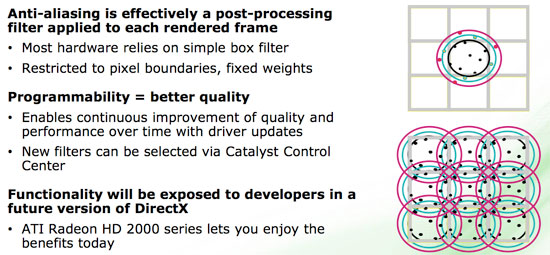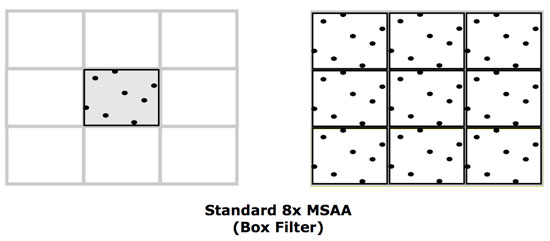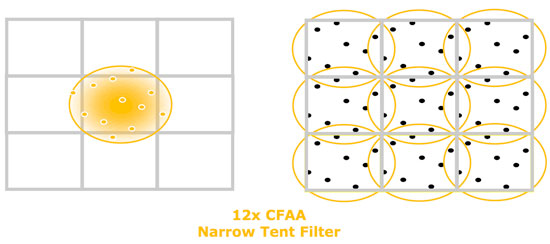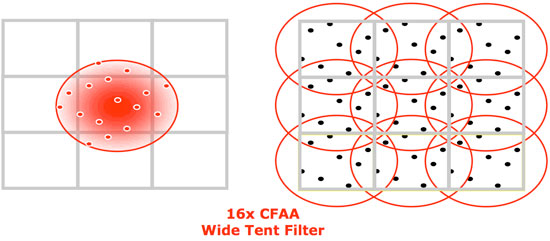ATI Radeon HD 2900 XT: Calling a Spade a Spade
by Derek Wilson on May 14, 2007 12:04 PM EST- Posted in
- GPUs
CFAA and No Fixed Resolve Hardware
That's right, R600 doesn't have hardware dedicated to resolving MSAA in the render back end - the only MSAA related tasks handled in the render back end are compression and evaluation of the subpixels. All antialiasing resolve is performed on the shader hardware. Certainly, AMD would prefer we start by telling you about the neat custom resolve filters that can be implemented on their shader hardware, but we would rather speculate about this for a moment first.
AMD has stated that, moving forward, in addition to allowing programmable sample patterns, future DX versions may allow for custom resolve filters as well. This is cited as one of the reasons why R600 uses shader hardware to resolve AA samples. AMD has given us a couple different resolve filters to play with, which we'll talk about in a minute. But at a point where we're seeing the first DX10 hardware from graphics makers, and at a time where competitive performance is paramount, it doesn't seem like the decision we would have made.
Whatever the circumstances, R600 sends its pixels back up from the render back ends to the shader hardware to combine subpixel data into a final pixel color. In addition to the traditional "box" filter (which uses subpixels within the area of a single pixel), the new driver offers the ability to use subpixel data from neighboring pixels resolved with a tent filter (where the impact of the subpixels on final color is weighted by distance). AMD calls this CFAA for custom filter antialiasing.

AMD currently offers narrow and wide tent filters which can be implemented using 2, 4, or 8 multisamples per pixel boundary. This gives us nine different AA options including traditional box filters. More filter options can be provided via driver updates, as these are essentially driver managed shader programs. Here's the breakdown of the options based on the type of filter and the number of samples used to resolve each pixel.



One of the useful side effects of these tent filters is that they are also capable of antialiasing interior pixels, not just those covered by more than one triangle. This is helpful in getting rid of aliasing in textures which can occur in certain cases.
While tent filters are a very interesting idea to improve antialiasing, they are not without their drawbacks. First, it is possible for tent filters, even though neighboring subpixel data is weighted less than internal subpixels, to create a muddy look, especially with high contrast fine detail like thin text for example. While tent filters can antialias textures on interior pixels, they can also create a blur effect where it isn't needed which removes detail from the scene.
Edge Detection
While tent filters are good in the general edge case, in order to be really compelling from an image quality stand point, AMD decided to go a step further and adaptively apply more AA in places where it would do the most good and less elsewhere. This will be done by applying an edge detect algorithm to the framebuffer and using more aggressive AA on these edges.
We learned that edge detection can be sped up by looking at pixel compression. If all the subpixels for one fragment are the same color, compression will be at its highest and there is no edge within that pixel. Beyond using this information, we are told that the algorithm uses straightforward derivative computations to find high frequency data (high contrast edges) much the same way Photoshop does.
The combination of edge detection and tent filters gives us two extra option beyond the ones listed above: 12x narrow tent filter with edge detect and 24x wide tent filter with edge detect. These filters are capable of very good image quality, though this quality does come at a performance cost. We will take a look at performance and image quality after we finish going through R600 hardware.










86 Comments
View All Comments
mostlyprudent - Monday, May 14, 2007 - link
Frankly, neither the NVIDIA nor the AMD part at this price point is all that impressive an upgrade from the prior generations. We keep hearing that we will have to wait for DX10 titles to know the real performance of these cards, but I suspect that by the time DX10 titles are on the shelves we will have at least product line refreshes by both companies. Does anyone else feel like the graphics card industry is jerking our chains?johnsonx - Monday, May 14, 2007 - link
It seems pretty obvious that AMD needs a Radeon HD2900Pro to fill in the gap between the 2900XT and 2600XT. Use R600 silicon, give it 256Mb RAM with a 256-bit memory bus. Lower the clocks 15% so that power consumption will be lower, and so that chips that don't bin at full XT speeds can be used. Price at $250-$300. It would own the upper-midrange segment over the 8600GTS, and eat into the 8800GTS 320's lunch as well.GlassHouse69 - Monday, May 14, 2007 - link
If I know this, and YOU know this.... wouldnt anandtech? I see money under the table or utter stupidity at work at anand. I mean, I know that the .01+ version does a lot better in benches as well as the higher res with aa/af on sometimes get BETTER framerates than lower res, no aa/af settings. This is a driver thing. If I know this, you know this, anand must. I would rather admit to being corrupt rather than that stupid.GlassHouse69 - Monday, May 14, 2007 - link
wrong section. dt is doing that today it seems to a few peoplexfiver - Monday, May 14, 2007 - link
Hi, thank you for a really in depth review. While reading other 'earlier' reviews I remember a site using Catalyst 8.38 and reported performance improvements upto 14% from 8.37. Look forward to Anandtech's view on this.xfiver - Monday, May 14, 2007 - link
My apologies it was VR zone and 8.36 to 8.37 (not 8.38)GlassHouse69 - Monday, May 14, 2007 - link
If I know this, and YOU know this.... wouldnt anandtech? I see money under the table or utter stupidity at work at anand. I mean, I know that the .01+ version does a lot better in benches as well as the higher res with aa/af on sometimes get BETTER framerates than lower res, no aa/af settings. This is a driver thing. If I know this, you know this, anand must. I would rather admit to being corrupt rather than that stupid.Gary Key - Tuesday, May 15, 2007 - link
I have worked extensively with four 8.37 releases and now the 8.38 release for the upcoming P35 release article. The 8.37.4.2 alpha driver had the top performance in SM3.0 heavy apps but was not very stable with numerous games, especially under Vista. The released 8.37.4.3 driver on AMD's website is the most stable driver to date and has decent performance but nothing near the alpha 8.37 or beta 8.38. The 8.38s offer great benchmark performance in the 3DMarks, several games, and a couple of DX10 benchmarks from AMD.
However, the 8.38s more or less broke CrossFire, OpenGL, and video acceleration in Vista depending upon the app and IQ is not always perfect. While there is a great deal of promise in their performance and we see the potential, they are still Beta drivers that have a long ways to go in certain areas before their final release date of 5/23 (internal target).
That said, would you rather see impressive results in 3DMarks or have someone tell you the truth about the development progress or lack of it with the drivers. As much as I would like to see this card's performance improve immediately, it is what it is at this time with the released drivers. AMD/ATI will improve the performance of the card with better drivers but until they are released our only choice is to go with what they sent. We said the same thing about NVIDIA's early driver issues with the G80 so there are not any fanboys or people taking money under the table around here. You can put all the lipstick on a pig you want, but in the end, you still have a pig. ;-)
Anand Lal Shimpi - Monday, May 14, 2007 - link
There's nothing sinister going on, ATI gave us 8.37 to test with and told us to use it. We got 8.38 today and are currently testing it for a follow-up.Take care,
Anand
GlassHouse69 - Monday, May 14, 2007 - link
wow dood. you replied!Yes, I have been wondering about the ethics of your group here for about a year now. I felt this sorta slick leaning towards and masking thing goign on. Nice to see there is not.
Thanks for the 1000's of articles and tests!
-Mr. Glass